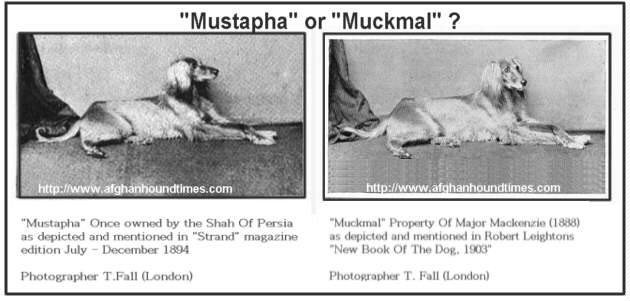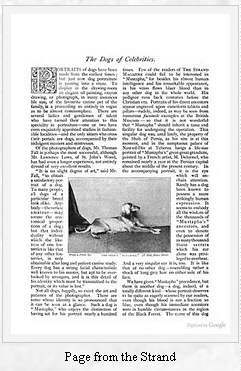|
|
|

OR
Is the dog above really called SHAH?
(Author - Jess Ruffner-Booth, of "DesertWindHounds" Salukis, Azawakh and Afghan crosses 2010)
Jess Ruffner-Booth has untangled quite a complicated history of name-changing for this one Afghan. With Jess's permission we publish her research writings on this issue below:
1. Mustapha/Muckmul
This left-hand photo comes from The New Book of the Dog : a comprehensive natural history of British dogs and their foreign relatives, with chapters on law, breeding, kennel management, and veterinary treatment, by Robert Leighton. It is identified as a Barukhzy hound, or Afghan Greyhound, belonging to Major Mackenzie.
The Mackenzie dogs were sparsely coated, like the so-called desert type Afghans later imported by Major Bell-Murray. The New Complete Afghan Hound, by Constance O. Miller and Edward M. Gilbert, is rather denigrating towards the Mackenzie dogs, calling Muckmul and Mooroo "just passable Afghan hounds," and "rather scraggly, smooth-skulled hounds." The authors hold up the publication of a single image of a dog of the 'mountain type', similar to Zardin, (imported in 1907 from Quetta, in what is now Pakistan,) as some kind of proof that the sparsely coated dogs like the Mackenzie and Bell-Murray hounds were of inferior stock, noting that "Vistiors to Afghanistan constantly repeat that the natives will rarely part with really good stock, and it is quite possible that Major Mackenzie knew of far handsomer hounds than he was able to take out of the country." Note the modern show fancier attempt to justify the favoring of and emphasis on heavily coated dogs. Many, many hounds from Afghanistan were and are sparsely coated, and are accepted as, well, really good stock in their country of origin, regardless of whether some foreigner considered them handsome or not. Of course those nakedy dogs weren't good Afghans. Only the hairy ones were. Unfortunately nobody bothered to ask the natives!
Barukhzy hounds are also mentioned in British Dogs, Their Points, Selection, And Show Preparation, 1903, by W. D. Drury, where Major Mackenzie is quoted:
Major Mackenzie thus writes: "The sporting dog of Afghanistan, sometimes called the Cabul Dog, has been named the Barukhzy Hound from being chiefly used by the sporting sirdars of the royal Barukhzy family. It comes from Balkh, the north-eastern province of Afghanistan, where it is believed that dogs of this variety entered the ark with Noah. That it is an old variety (probably the oldest domesticated breed in existence) is proved by very ancient rock-carvings, within caves of Balkh, of dogs exactly like the Barukhzy Hound of to-day. On some of these carvings, of colossal size, are inscriptions of much later date, that were written by invaders under Alexander the Great."
Drury goes on:
"To show what courage these hounds possess, Major Mackenzie relates how Koosh, the grandsire of the bitch Khulm (illustrated in "Practical Kennel Management"), alone killed a nearly full-grown leopard that was carrying away her dam Mooroo II., when she was a pup. The bitches, being kept in seclusion by the women (as carefully guarded as mares are in Arabia) except when required to hunt, are very shy. They usually hunt in couples, bitch and dog. The bitch attacks the hinder parts, and while the quarry is thus distracted, the dog, which has great power of jaw and neck, seizes and tears the throat. Their scent, speed, and endurance are remarkable; they track or run to sight equally well. Their long toes, being carefully protected by tufts of hair, are serviceable on both sand and rock. Their height varies from 24 in. to 30 in. ; their weight from 451b. to 70lb. Usually they are of fawn or of bluish-mouse colour, but always of a darker shade on the back, which is smooth and velvety. The Shah owned a well-known dog of this variety, named Muckmul, meaning "velvet."
Let's just ignore the fact that all that stuff about caves and carvings is utter crap. No such carvings or caves have ever been found in Afghanistan. Most of the rest is probably embellished, as well. People love a good story, though, and obviously Major Mackenzie was willing to give them one. Drury notes that his correspondence with Major Mackenzie took place "some six years ago," or about 1897. I had always thought that the dog pictured in the Leighton book was likely to be Muckmul, and it turns out I was right. Ownership of Muckmul is always attributed to Major Mackenzie, and there is no mention that he might not have come from Afghanistan. Drury's mention of the 'Shah' owning a dog named Muckmul seems to be a slip of the lip, or perhaps, a hint.
The 'Shah's' dog is mentioned in other texts, specifically the Afghan Handbook, by Clifford 'Doggy' Hubbard, published in 1951, the first book on the Afghan hound, but in this account it's name is Mustapha. Hubbard writes that Mackenzie's dog Muckmul, the dog in the Hyland painting, "was rather like Mustapha, who came to Britain with the Shah of Persia." Mustapha is mentioned again by Margaret Niblock in the Afghan Hound, a Definitive Study, in reference to Muckmul, "The latter was reputed to be similar to the hound Mustapha, probably of desert type, brought to Britain by the Shah of Persia." (Ms. Niblock, by the way, is kinder than Miller and Gilbert, saying of the lying down Mackenzie dog, that it had a "well balanced head.") It is likely that Niblock's reference on Mustapha is actually Hubbard, and Hubbard's was probably Drury, considering that the Afghan Handbook was written almost fifty years after British Dogs. So neither author had any firsthand knowledge of Mustapha and were just repeating what they had read elsewhere. However, that's not what is so interesting about Mustapha.
Nowhere is this Shah's name mentioned, probably because he would have been quite famous in Britain at the time and the name was not necessary. A quick bit of research tells us that the Shah of Persia at that time was Nasser al-Din Shah Qajar, who was King and Shah of Persia from September 17, 1848 to May 1, 1896 (when he was assassinated), and first visited Britain in 1873. He went on tours of Europe in 1878 and 1889. Persia is now Iran, which is right next door to Afghanistan, a point I've made several times in regards to brindle and blue colors in Salukis and which always seems to fall on deaf ears.
Two mentions of 'Muckmul's' resemblance to a dog from Persia named Mustapha, and one mention of 'Muckmul' being owned by the Shah. I decided to hit the Googles, and lo and behold the first hit was in Google Books, an issue of the Strand Magazine, from 1894, an article about the dogs of celebrities, including Mustapha. Considering the dates, it's pretty obvious that Mustapha accompanied the Shah on his trip in 1878.
The strand has this to say about Mustapha:
"Not all dogs, happily, so exact the art and patience of the photographer. There some whose identity is so pronounced that it can be seen at a glance. Such a dog is "Mustapha," who enjoys the distinction of having sat for his portrait nearly a hundred times. Few of the readers of the The Strand Magazine could fail to be interested in "Mustapha," for besides his almost human intelligence and his remarkable appearance, in his veins flows bluer blood than in any other dog in the whole world. His pedigree runs back centuries before the Christian era. Portraits of his direct ancestors appear engraved upon cuneiform tablets and pillars-rudely, indeed, as may be seen from numerous facsimile examples at the British Museum- so that it is not wonderful that "Mustapha" should inherit a taste and facility for undergoing the operation. This singular dog was, until lately, the property of the Shah of Persia, as his sire is at this moment, and in the sumptuous palace of Nasr-ed-Din at Teheran hangs a life-size portrait of "Mustapha's" great-great-grandsire, painted by a French artist, M. Delormel, who remained nearly a year at the Persian capital about the middle of the century. In the accompanying portrait, it is the eye which will enchain attention. Rarely has a dog been known to posses a more strikingly human expression. It seems to embody all the wisdom of the thousands of "Mustapha's" ancestors, and even to denote the possession of as many thousand State secrets which his ear alone was privileged to overhear. And a very singular ear it is, too. It is like that of no other dog- resembling rather a shock of long grey hair on either side of his face."

The 'accompanying portrait.' Look familiar? This is obviously the same dog as the one pictured in the Leighton book. At the same photo session, no less. Not only was Muckmul 'rather like' and 'similar' to Mustapha, Muckmul was Mustapha, as intimated by Drury.
2. Mustapha/Muckmul - Shah
In the process of researching Muckmul/Mustapha, I happened on yet another mention, in Brian Duggan's book, Saluki: the Desert Hound and the English Travelers Who Brought It To The West. On page 60, Duggan writes:
"In the "Kennel Notes" column of Country Life, July 16, 1898, an illustrated section was devoted to a Persian Greyhound named Shah. The hound was the former property of a Persian prince who had traded him to one Colonel Mackenzie for the Englishman's Arab pony. The columnist recalled an earlier incident where a dog in the variety classes resembling Shah puzzled the judges, one of whom declared that no such dog dog had ever been in England before (much like Dalziel's assertion about Zillah). An older show catalog was produced with a description of a similar dog, a "Persian Greyhound, not unlike a broad-skulled Borzoi," and the dispute was settled. Shah's head study was considered to be a fine visualization of that description. Indeed, to the modern eye, it is a typical Saluki head, although the shoulders appear to have more hair than usual, but certainly less than the Afghan hounds of the period. Shah's gentle disposition, playfulness, and faraway look were particularly remarked upon - as was his slight tendency toward melancholia."
Now, remembering that information often passed through several hands before publication, and second-hand information is often unreliable, the coincidence of 'Persian prince' and 'Mackenzie,' even with the erroneous rank, caught my attention. I sent my two pictures of Muckmul and Mustapha to Mr. Duggan, and he confirmed for me that Shah was the same dog as Muckmul/Mustapha. The image in Country Life was the same as the one in the New Book of the Dog, cropped to show only the head.
Muckmul gains, in a way, a third identity, that of Shah, the Persian greyhound, shown as a Persian greyhound in the Foreign Dogs class.
Jess Ruffner-Booth 2010 ("DesertWindHounds" Salukis, Azawakh and Afghan crosses)
Or Return to EARLY AFGHAN HOUNDS

Or Click The
Of The Browser To Close This Window